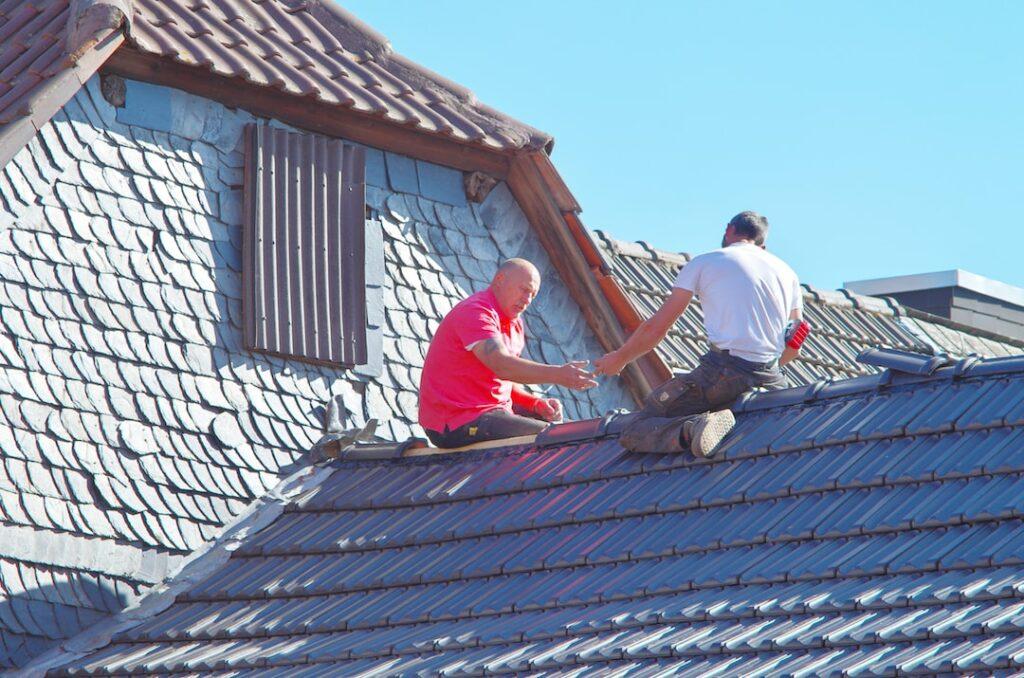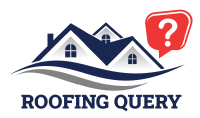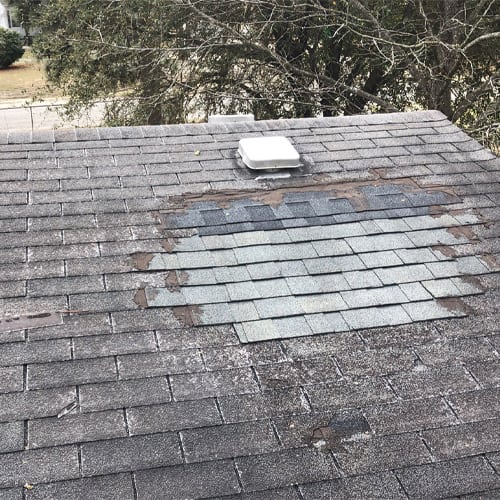Common signs of roof damage include missing shingles, leaks, and daylight shining through the roof boards. Sagging areas and granules in gutters also indicate problems.
Ensuring the longevity of your roof requires vigilance and timely maintenance. Homeowners should remain alert to the warning signals that spell trouble for their roof’s integrity. Watching for these indicators can save you from costly repairs and extensive damage in the long run.
A compromised roof not only threatens the structure of your home but can also lead to increased energy bills and security concerns. By addressing issues early, you protect your property value and maintain a safe living environment. Regular inspection by professionals or a self-check after severe weather will keep you ahead of any potential roofing woes. Remember, a durable and robust roof is pivotal to your home’s overall health.
Recognizing Roof Damage Signs
Your home’s roof is its first line of defense against the elements; thus, staying vigilant about roof health is crucial. Identifying the common signs of roof damage early on can save you from unexpected leaks and costly repairs. Let’s explore how regular inspections, understanding potential costs, and considering the influence of climate can help in maintaining your roof’s integrity.
Importance Of Regular Roof Inspections
Conducting regular roof inspections is an essential practice to ensure the longevity of your roofing system. These inspections often reveal minor issues that could rapidly escalate into major problems. Here are some key benefits:
- Detection of early signs of wear and tear
- Identification of missing, broken, or curling shingles
- Spotting blocked or malfunctioning gutters and downspouts
- Assessment for mold, rot, or moisture build-up
- Checking for damaged flashing and sealant integrity
Bi-annual inspections, particularly before and after extreme weather seasons, are recommended for best upkeep practices.
Potential Costs Of Ignoring Roof Damage
Overlooking roof damage can lead to spiralling costs down the line. Here are some of the financial implications if damage is ignored:
| Roof Damage | Short-Term Costs | Long-Term Costs |
|---|---|---|
| Minor Leaks | Moderate repair expenses | Can escalate to major structural damage |
| Shingle Damage | Low-cost replacement of individual shingles | Full roof replacement if not addressed |
| Water Damage | Repair of the affected area | Risk of mold and compromised building integrity |
Ensuring timely repairs can significantly reduce these costs and extend the life of your roof.
Influence Of Climate On Roof Integrity
The local climate you reside in greatly affects the integrity of your roofing materials. Different weather patterns demand unique considerations:
- High winds can lift or remove shingles and flashing
- Heavy rains can exacerbate leaks and moisture-related damage
- Snow and ice can lead to ice dams and extra weight on the structure
- Extreme heat can cause materials to expand, contract, and degrade faster
By understanding your climate’s impact, preventative measures can be implemented to mitigate roof damage, such as choosing appropriate roofing materials and regular maintenance checks.
Visual Symptoms Of Roof Degradation
Keeping your home safe starts with a solid roof overhead. Awareness of the visual signs of roof degradation is critical for maintaining your home’s integrity and avoiding costly repairs in the future. Roof damage can manifest in various ways, and early detection is essential. Let’s delve into the telltale signs visible to the naked eye that indicate your roof needs attention.
Discolored Or Dark Spots On The Roof
Discoloration or dark spots on your roofing material can be more than just an eyesore; they can be symptomatic of deeper issues. Algae growth, water damage, and loss of granules are just a few causes of these unsightly blemishes. It’s essential to inspect these spots closely as they may point to moisture problems that could lead to leaks or structural damage over time.
Cracked, Curled, Or Missing Shingles
When shingles start showing signs of wear such as cracking, curling edges, or if they are missing entirely, it is a clear indicator of roof deterioration. These symptoms suggest aging, weather damage, or improper installation. Damaged shingles compromise the roof’s ability to protect your home from the elements, making timely repairs paramount.
Presence Of Shingle Granules In Gutters
As shingles age, it’s natural for them to lose their granules—but when your gutters become filled with these gritty particles, it’s a sign of accelerated wear. Frequent sighting of granules in your gutters or downspouts usually indicates shingles are nearing the end of their lifespan and may require replacement to prevent any further roof damage.
| Sign | Possible Cause | Action to Take |
|---|---|---|
| Discolored Spots | Algae, moisture, granule loss | Inspection and potential roof cleaning or repair |
| Cracked or Curled Shingles | Aging, weather damage | Roof assessment and repair or replacement of shingles |
| Granules in Gutters | Aging shingles, excessive wear | Professional roof inspection and possible shingle replacement |
Internal Evidence Of Leaks
Your home’s roof is its first line of defense against the elements, but it’s not indestructible. Over time, it can succumb to wear and tear, leading to potentially serious issues like leaks. Recognizing the internal evidence of leaks early on can prevent extensive damage and costly repairs. Diligence is key, so here’s what to look out for inside your home to keep your roof in top condition.
Water Stains On Ceilings Or Walls
One of the most apparent indicators that your roof may be compromised is the appearance of water stains on your ceilings or walls. These discolored spots often have a brownish or yellowish hue and may spread or change shape after a heavy rain. Inspect your home regularly, especially after storms, for these telltale signs. It’s crucial to address these issues promptly as they can weaken the structural integrity of your home over time.
Unusual Musty Odors In The Attic
Another red flag to watch out for is an unusual musty odor in your attic. This smell can indicate prolonged exposure to moisture, suggesting that your roofing system isn’t keeping water out effectively. Frequent attic inspections can help catch this early on. Note any changes in the scent, particularly after rainfall, and take action if you detect persistent, musty smells.
Mold Or Mildew Growth Indoors
The presence of mold or mildew growth indoors is not only unsightly but also poses health risks to inhabitants. These fungi thrive in moist environments, making a leaky roof a prime breeding ground. Check corners, behind furniture, and any other places with minimal airflow for signs of growth. Cleaning mold or mildew is not sufficient; locating the root cause—often a roof leak—is essential to preventing further infestations.
- Thoroughly examine ceilings and walls for water stains.
- Smell for mustiness in your attic after rainfalls.
- Look for signs of mold or mildew in damp areas of your home.
| Sign of Damage | Location | Recommended Action |
|---|---|---|
| Water Stains | Ceilings/Walls | Inspect and Repair Roof |
| Musty Odors | Attic | Enhance Ventilation, Inspect Roof |
| Mold/Mildew | Indoor Damp Areas | Clean and Eliminate Moisture Source |
Addressing these common signs of roof damage without delay can save you time and money in the long run, ensuring that your home remains safe, dry, and comfortable.
Roof Damage You Shouldn’t Ignore
When it comes to maintaining your home, identifying and addressing roof damage should be a top priority. Your roof is the first line of defense against the elements, and even minor issues can escalate into costly repairs if ignored. Recognize the signs of wear and damage early on to protect your home’s structural integrity and avoid a full-blown disaster. Below are vital warning signals that your roof may be in trouble and should prompt immediate action.
Sagging or Drooping Roof DeckSagging Or Drooping Roof Deck
A sagging or drooping roof deck is a clear indicator that your roof could be failing. This could manifest as dips or curves in the lines of the roof, or areas where the roof appears to be weighed down. You might notice this from the ground or more clearly when viewing the roof from a higher vantage point. Deterioration in the roofing structure, water accumulation, or undue weight on the roof can cause sagging. This concern demands immediate attention to prevent further damage or potential collapse.
Light Visible Through the RoofLight Visible Through The Roof
If you can see streaks of light coming through the top of your house, take action quickly. Light penetration often points to cracks, holes, or gaps in the roofing material, which could let water and pests into your home. This kind of damage doesn’t just affect the roof; it can compromise insulation, increase energy bills, and cause water damage to interior structures and belongings. Inspect your attic during daylight hours to spot these breaches in your roof’s defenses.
Structural Integrity ConcernsStructural Integrity Concerns
Structural integrity concerns should never be underestimated. Signs such as cracked or buckling shingles, an influx of shingle granules in gutters, or evident rotting can all signal that the roof’s condition is compromised. When the integrity of the roof is questionable, your home is exposed to potential leaks, mold growth, and weakened structural support. A professional inspection can diagnose the severity of these issues and guide you towards the necessary repairs or replacement.
Unseen Hazards To Roof Health
Unseen hazards to roof health may not catch your eye like a missing shingle would, but they can be equally, if not more, detrimental to the integrity and longevity of your roofing system. It’s essential to be vigilant about these often-overlooked threats that can stealthily compromise your home’s first line of defense against the elements. The following sections shed light on some insidious risks that your roof may be facing right now.
Ice dams forming at the roof’s edgeIce Dams Forming At The Roof’s Edge
The accumulation of ice on the eaves of your roof creates what is known as an ice dam. This blockage can prevent melting snow from adequately draining, causing water to back up under your shingles and potentially leading to severe water damage. Signs to watch for include icicles along the edge of the roof and any water spots on your ceiling – subtle indicators of a much bigger problem.
Damage from nearby tree limbsDamage From Nearby Tree Limbs
While trees enhance your property’s aesthetics and provide shade, limbs hanging over your roof can be a hazard. Wind, storms, or just the weight of the tree limb can cause it to fall and damage your roof. Branches also grant animals access to your roof, where they can cause additional harm. It’s critical to trim any overhanging limbs to preserve the safety and health of your roofing system.
Clogged gutters affecting the roof’s slopeClogged Gutters Affecting The Roof’s Slope
Clogged gutters are more than just a nuisance; they pose a serious threat to the structural integrity of your roof. When gutters fill with leaves, sticks, and other debris, they can prevent proper drainage. This can result in water pooling on your roof, increasing the load and potentially leading to sagging or roof slope distortion. Regular gutter cleaning is vital to avoid these unseen perils.
Proactive Roof Maintenance Strategies
Ignoring roof damage could lead to extreme consequences for a homeowner’s sanctuary. The roof is the primary barrier against the elements, and its wellbeing is crucial. Staying ahead of potentially disastrous issues requires adopting proactive roof maintenance strategies. This part of the post focuses on effective ways homeowners can keep their roof in top condition, detect concerns early, and implement measures to extend its lifespan.
Regular Professional Inspections
One cannot understate the importance of having trained eyes evaluate the integrity of a roof. Regular inspections by professionals can uncover hidden problems before they escalate.
- Biannual checks are recommended; once before the harshest weather season, and once after.
- Professionals can spot subtle signs of wear and abnormalities such as missing granules, cracked shingles, or moss growth.
- Inspections could also include gutter cleaning and assessment of the roof’s support structure.
Timely Repairs And Preventive Measures
Upon identifying any roof damage, timely repairs are non-negotiable. Preventive measures can also fortify the roof against future problems.
Immediate action minimizes the risk of water damage from leaks, which can lead to costly interior repairs.
- Waterproof sealants around chimneys and vents.
- Replacement of worn or damaged shingles.
- Better attic insulation to prevent ice dam formation.
Importance Of Seasonal Roof Care
Seasonal changes can take a toll on roofing materials. Adapting maintenance to the season is crucial.
| Season | Maintenance Focus |
|---|---|
| Spring | Post-winter inspection, cleaning of debris. |
| Summer | Checking for UV damage and ventilation issues. |
| Fall | Cleaning gutters, checking for damage before winter. |
| Winter | Post-storm inspections, preventing ice dams. |
Seasonal care ensures that the roof is prepared for upcoming weather changes, thereby prolonging its life and safeguarding the home.

Credit: garlock-french.com
Frequently Asked Questions For Common Signs Of Roof Damage You Shouldn’t Ignore
What Are Typical Roof Damage Indicators?
Roof damage is often signaled by missing shingles, leaks, and water stains on ceilings or walls. Inspect your roof regularly for these signs to prevent further damage and potential costly repairs.
How Can I Spot A Leaking Roof Early?
Look for water spots on your ceiling, especially after a storm. Musty odors in certain rooms or visible mold can also indicate a leak. Check for dampness along the attic rafters as another early sign.
Can Hail Damage Affect Roof Longevity?
Yes, hail can bruise or crack shingles, weakening the roof’s integrity. Over time, this can lead to leaks and shorten the lifespan of your roof. Post-storm inspections are crucial to address any hail damage quickly.
Why Is Roof Sagging A Serious Issue?
Roof sagging is a structural concern indicating weakened support or heavy weight burden. It is critical to address it immediately to prevent potential roof collapse and ensure the safety of the building’s inhabitants.
Conclusion
Maintaining a sturdy roof overhead is crucial for your home’s integrity. Keep alert for the telltale symptoms of roof damage we’ve outlined. Prompt action can prevent minor issues from escalating. Remember, catching signs early could save on costly repairs. Prioritize your roof’s health for lasting safety and comfort.

